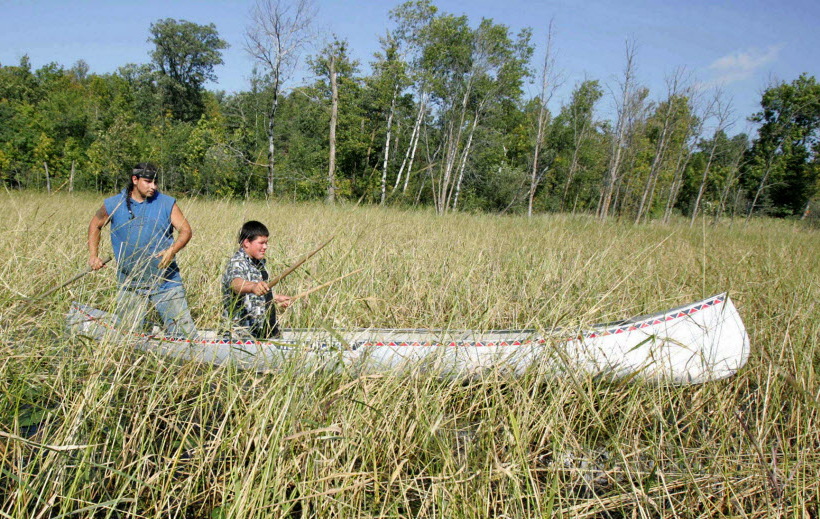Notable Native chefs and American Indian Movement representatives traveled to Tours, France, earlier this month to promote indigenous foods from Minnesota. Among them were The Sioux Chef Sean Sherman and his Chef de Cuisine Brian Yazzie. Several proponents of White Earth Real Wild Rice also traveled overseas with the Minnesota coalition for La Foire de Tours, one of the largest culinary and arts festivals in France. The May 4-10 event drew more than 30,000 attendees, who sampled their wild rice, walleye and buffalo from various Minnesota-based tribes.
White Earth Real Wild Rice grows and harvests the only “naturally organic wild rice in the world.” White Earth Tribal officials hope to appeal to the discerning France palate and capture a substantial export market. “The French are bonkers about the best foods. I knew White Earth wild rice would have a future in France,” Diane Gorney, a board member of the American Indian Movement Interpretive Center (AIM IC) in Minneapolis, told the StarTribune.
Gorney, a retired Minnesota art educator from White Earth, inspired the trip. She believes French fans of specialty foods will embrace true wild rice, harvested by Indians from their fresh-water lakes, where the grain naturally grows. Each fall, hundreds of members of the White Earth Band of Chippewa Indians paddle canoes into the marshes to hand harvest the rice from the roughly five-foot-tall aquatic plant native only to North America.
In addition to Gorney, AIM IC reps in attendance included Clyde Bellecourt, Norma Renville, Eric Byrd, Jack Swanson, Carl Fransen (also of the White Earth Urban Office) and Mike O’Dell. (Founded in July 1968, the AIM IC holds a legacy of millions of historical records, culture captured on media, radio archives, photographs and the testimony of living elders who want the story of the American Indian Movement told.) Meanwhile, Howasta Means represented Gatherings Café, a social enterprise of the Minneapolis American Indian Center. The community-embraced café in Minneapolis encourages living healthy, eating healthy and education through ancestral knowledge.
Native and Minnesota delegates also offered indigenous food recipes in French at La Foire de Tours. Meanwhile, world champion Midnight Express Drummers and Native Pride Dancers performed, and two tipis were built and displayed featuring paintings by Wolf Bellecourt, reported alleynews.org.
Defending their wild rice beds, lakes and rivers
While Native food sovereignty advocates are promoting wild rice and other indigenous foods overseas, they are also waging a battle to protect their land and water. The proposed Line 3 Pipeline would transport tar sands oil over 1,000 miles, from Hardisty, Alberta, to Superior, Wisconsin, cutting through the heart of Anishinaabe territory in Minnesota, and threatening precious lakes and wild rice beds.
On May 15, the State of Minnesota released its Draft Environmental Impact Statement (DEIS) for Enbridge’s proposed new Line 3 pipeline—which directly threatens Minnesota, home to one-fifth of the world’s fresh surface water supply, according to Honor the Earth. The State of Minnesota will hold 22 public meetings in June 2017, all over Minnesota, to gather public comment on the DEIS. In theory, they will use the public comments to make improvements before issuing the Final EIS later this year.
Honor the Earth is a Native-led organization, established by Winona LaDuke and Indigo Girls Amy Ray and Emily Saliers, in 1993 to address the two primary needs of the Native environmental movement: the need to break the geographic and political isolation of Native communities and the need to increase financial resources for organizing and change.
“Our wild rice beds, lakes, and rivers are precious – and our regional fisheries generate $7.2 billion annually, and support 49,000 jobs. The tourism economy of northern Minnesota represents $ll.9 billion in gross sales (or 240,000 jobs),” writes LaDuke, who also founded the White Earth Land Recovery Project to preserve the land, the harvest, as well as language fluency, community development, and strengthening the Ojibwe spiritual and cultural heritage.
“The proposed route endangers three of the continent’s major watersheds including the Great Lakes, home to one fifth of the world’s fresh water. It would also pierce the heart of Ojibwe treaty lands, where members of signatory bands retain the rights to hunt, fish, gather, hold ceremony, and travel. It is our responsibility as water protectors to prevent this. We will not allow Line 3 to desecrate our lands, violate our treaty rights, or poison our water,” LaDuke states.
For more information about the $7.5 billion Line 3 Pipeline, the largest project in Enbridge’s history that would be one of the largest crude oil pipelines in the continent, carrying up to 915,000 barrels per day, check out LaDuke’s video:
